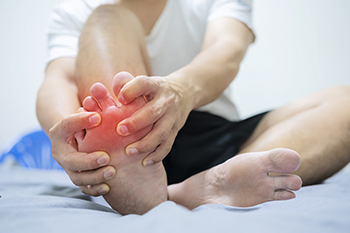
Gout is a type of inflammatory arthritis that often affects the feet and ankles, causing intense pain and swelling. It occurs when uric acid crystals build up in the joints, typically starting with a sudden, severe flare in the big toe. Symptoms include sharp, burning pain, redness, warmth, and stiffness in the affected joint. Flares can last from days to weeks, often becoming more frequent if not managed properly. Repeated gout attacks can lead to tophus formation, which are large, painful deposits of uric acid crystals in soft tissues. Bony erosion can also occur which can permanently damage the joints. Over time, this can develop into chronic arthritis, making movement difficult and painful. Treatment focuses on reducing inflammation with medications, lowering uric acid levels through lifestyle changes, with an emphasis on proper diet and hydration. If you have symptoms of gout, it is strongly suggested that you visit a podiatrist for a proper diagnosis and care.
Gout is a painful condition that can be treated. If you are seeking treatment, contact one of our podiatrists from Jill Einhorn, DPM and James Einhorn, DPM. Our doctors will treat your foot and ankle needs.
What Is Gout?
Gout is a form of arthritis that is characterized by sudden, severe attacks of pain, redness, and tenderness in the joints. The condition usually affects the joint at the base of the big toe. A gout attack can occur at any random time, such as the middle of the night while you are asleep.
Symptoms
Risk Factors
Prior to visiting your podiatrist to receive treatment for gout, there are a few things you should do beforehand. If you have gout you should write down your symptoms--including when they started and how often you experience them, important medical information you may have, and any questions you may have. Writing down these three things will help your podiatrist in assessing your specific situation so that he or she may provide the best route of treatment for you.
If you have any questions, please feel free to contact our offices located in Brooklyn and Astoria, NY . We offer the newest diagnostic and treatment technologies for all your foot care needs.